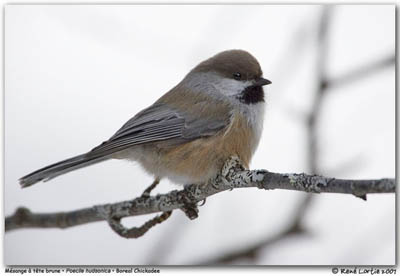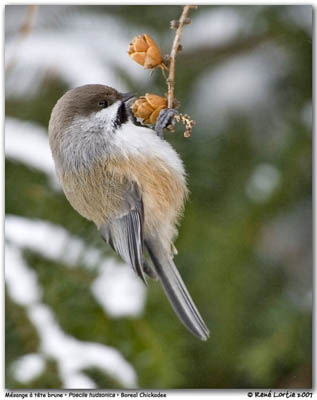
Boreal Chickadee
Poecile hudsonicus
Passeriforme Order – Paridae Family
BIOMETRICS:
Length: 12-14 cm
Wingspan: 20 cm
Weight: 7-12 g
LONGEVITY : Up to 4 years
DESCRIPTION:
Boreal Chickadee has grey brown upperparts. Underparts are whitish, washed with brown cinnamon on vent, sides and flanks. It has black bib. Wing coverts and tail are all-grey.
Head is brown with white cheeks. Eyes are black. Short pointed bill is black. Legs and feet are dark grey.
Both sexes are similar.
Immature resembles adults.
To feed, Boreal Chickadee gleans seeds and insects from shrub and tree bark. It may hang upside down to feed. It also frequents bird feeders. They may feed with other chickadee species. They hop on twigs and branches, and forage within the thick foliage.
Boreal Chickadees are monogamous and may nest in small colonies. They are cavity-nesters. Pair remains together all year round, and may mate for life.
FLIGHT:
Boreal Chickadee performs weak fluttering short flights with rapid wing beats. It is an acrobatic flyer.
REPRODUCTION:
Boreal Chickadee is a cavity nester, and female, sometimes helped by male, excavates or enlarges a cavity in soft wood. They may use an old woodpecker hole, or sometimes hollows in the earth under tree roots. Nest is usually located at about 12 feet above the ground.
Female builds a nest in the cavity, with moss, lichens and bark strips, and she lines this foundation with hair (from rabbit), feathers and plant down.
Female lays 4 to 9 white eggs with fine red-brown spots, or olive or grey markings. Incubation lasts about 14 to 18 days, by female. Male feeds her while she incubates. Altricial chicks are brooded by female during the first days after hatching, and male brings food to female and young at nest. Then, female joins male to bring food. Young leave the nest at about 18 days after hatching, but they remain two weeks more in the parental territory. They are fed by adults while they learn to forage themselves.
This species produces only one brood per season.
DIET:
Boreal Chickadee feeds on insects (pupae and eggs), spiders and seeds. During breeding and nesting period, they feed mainly on caterpillars and animal matter.
PROTECTION / THREATS / STATUS:
Boreal Chickadee’s populations are considered stable. They use both mature and younger forests, which help them to secure their numbers.
Fr: Mésange à tête brune
All : Hudsonmeise
Esp : Carbonero Boreal
Ital : Cincia boreale
Nd : Bruine Mees
Sd : Kanadames
Photographs by René Lortie
His website : http://rlortie.ca/
Text de Nicole Bouglouan
Sources :
HANDBOOK OF THE BIRDS OF THE WORLD Vol 12 by Josep del Hoyo-Andrew Elliott-David Christie - Lynx Edicions - ISBN: 8496553423
FIELD GUIDE TO THE BIRDS OF NORTH AMERICA - National Geographic Society - ISBN: 0792274512
All About Birds (Cornell Lab of Ornithology)
Bird Web (Seattle Audubon Society)
Wikipedia (Wikipedia, The Free Encyclopedia)

VOICE: SOUNDS BY XENO-CANTO
Boreal Chickadee’s call is a nasal “tseek-a-dee-dee-“. Song is a short warbler, with “p-twee-titititititi” introductory notes.
HABITAT:
Boreal Chickadee is common in coniferous forests, mainly in black spruce (Picea mariana) and balsam fir (Abies balsamea).
In winter, it frequents feeding stations in towns, and populations move according to food resources. They may be found from 180 to 1500 metres in elevation. They are resident in boreal forests.
RANGE:
Boreal Chickadee is resident from Alaska to Newfoundland, and southwards, to northern United States.
BEHAVIOUR:
Boreal Chickadee spends most of its time in dense spruces. During late summer and fall, these birds store food for winter, mainly caterpillars and seeds, among needles or under the bark, at high level in trees, above the snow cover.
